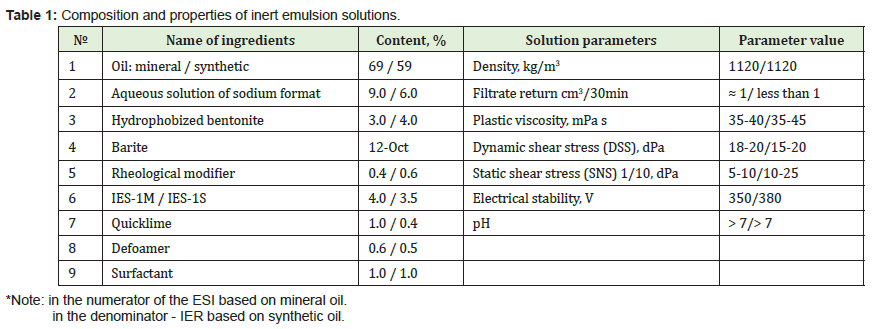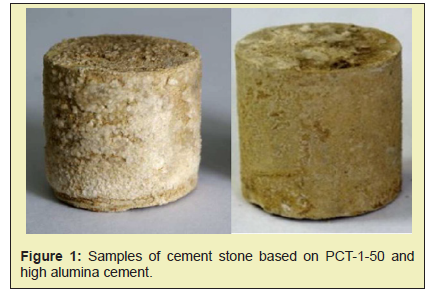In the work, a study was made of the rheological and physical-mechanical properties of cement grout mixture and grout cements. For a qualitative cementing process, an analysis of cement slurries was carried out with a study of changes in the consistency of cement slurries after a certain time. Thus, the acceleration of the process of drilling observation and production wells depends on the correct selected cement slurry.
Keywords: Drilling mud, Well, Temperature, Pressure, Portlancement, Inert emulsion mud
Oil-based emulsion drilling fluids are divided into two groups - emulsions of the first type and the second - reverse or invert emulsions. If the first hydrocarbon liquid is dissolved, then the latter are represented by dissolved water in the hydrocarbon liquid.1
Thus, depending on what is the dispersed phase and what is the dispersion medium, groups of emulsions are determined. According to the purpose, the solutions are divided into two groups - drilling fluids and special fluids (for work over (work over) and underground well work over, perforating and conservation fluids).2
An alternative to oil-based mud (OBM) are polyethylene glycol-based muds that are environmentally friendly in use.
OBM have disadvantages - low stability of physical and mechanical properties, significant material and time costs for their preparation and disposal, negative impact on the environment, labor intensity, dependence of mineral oils on external factors (temperature, pressure, chemical aggression of formation fluids).3 These problems with the use of OBM are solved with the use of synthetic and semi-synthetic oils, repeated use and an increase in the degree of "cut-off" of the oil during disposal.
To solve problems, the composition of the solution is provided using emulsion medium viscosity oils such as VMGZ 60 and VMGZ 45; emulsifier reagents KES-1M and KES-1C; regulators of rheological properties of organophilic clays (organobonite, beto-34), surfactants (surfactants) (neonol), biopolymers - PAC, KMK; to control the density of the drilling fluid - barite, calcium carbonate; in the defoamer - organosilicon liquids of the type Penta 467 or Penta 468 type. The composition and certain properties of the proposed solution inverter solution are given in Table 1.

According to the data from the table, it should be noted that the proposed composition of the solution can be weighted by introducing a weighted additive. However, other indicators of the solution do not differ from the earlier ones.
When applying the technology of thermal action on the formation, the maximum thermal and physical loads occur in the rock and well lining - thermal expansion accompanying the formation of thermo mechanical stresses, destruction of the cement stone caused by the processes of interfacial transformations (recrystallization) of high-basic and low-basic hydro silicates.
The solution to this problem is possible due to the formation of low-basic calcium hydrosilicates in the forming stone even at the early stages of hardening by introducing silicon additives into the binder composition (Portland cement) or using slag compositions or cements of various raw materials - aluminum oxide, calcined silicon dioxide, white silicon dioxide.
The results of experimental studies have shown that the most heat-resistant stone is formed by a composition of aluminum cement in combination with Portland cement PCT-1-50 and microsphere additives (KMD), fine ash from a thermal power plant (CHP), as well as high-alumina cement in combination with Portland cement, slag and barite additives. For example, in Figure 1 shows samples of cement stone based on PCT-1-50 and high alumina cement after thermal treatment, which clearly confirm the above.

When the content of the slag component of the composite material is in the range of 20 - 80%, there is no change in the strength parameters after 90 days of the samples at an ambient temperature of about 160°C. Small changes were identified in the direction of reducing the slag content of 20 and 50%, which is fully explained the content of Portland cement, namely to the phenomenon of destruction of its hydration. At a lower content, on the contrary, the effect of stability appears and the tensile strength increases.
The highest values of stability and final strength are observed during the hardening of mixtures on the first day. Reducing the content of the slag component in the mixture leads to an increase in the setting time and reduce the power of the formed stone. At the same time, it was found that these indicators initially increased, but then after reaching the maximum (certain) value, they decreased. The optimal amount of blast-furnace slag in cement is 80%.
Thus, it is experimentally confirmed that the compositions of cement stones in combination with blast-furnace slag meet the basic requirements (in terms of the physical and mechanical properties of cement slurries) for well casing in areas of elevated temperatures. Over time, the cement stone does not lose its strength, which is important, because the resulting stone is considered not only as a means of fastening the casing string (OC), but also as a heat-insulating material, which is especially important when using thermal methods of oil production (for example, combined methods of steam-gas oil extraction).4
The results of technical and technological solutions for deepening wells show their effectiveness in many areas in Western Siberia.
None.
None.
Author declares that there is no conflict of interest.
- 1. Shemelina ON. Study of drilling fluid formulations. Collection of abstracts of the X international scientific and practical conference: collection of abstracts of the conference. 2020. p. 198-201.
- 2. Shemelina ON. Analysis of the technical and economic indicators of drilling when using polymer solutions. Proceedings of the X International Scientific and Practical Conference. 2021. p. 173-177.
- 3. Shemelina ON. Analysis of the construction of wells intended for the production of high-viscosity oils. Proceedings of the XXV International Symposium named after Academician M.A. Usov of students and young scientists, dedicated to the 120th anniversary of mining and geological education in Siberia, the 125th anniversary of the founding of Tomsk Polytechnic University. 2021. p. 363-364.
- 4. Shemelina ON. Research and analysis of cement slurries. Problems of development of deposits of hydrocarbon and ore minerals. 2021. p. 459-464.

